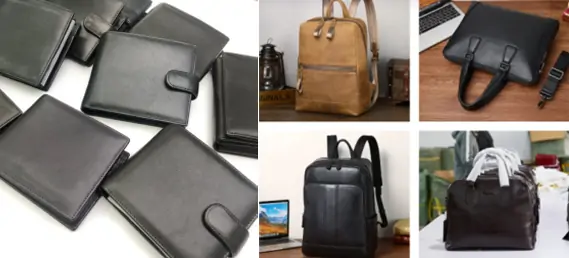As a leather goods factory, every material choice we make directly impacts production efficiency, product yield, and client (brand) satisfaction. Among the countless material consultations we handle daily, the discussion around full grain leather vs genuine leather is the most frequent—and critical. Unlike brands that focus solely on market positioning, we need to weigh not just “quality” or “aesthetics,” but also how each leather type performs on the production line, from cutting to stitching to finishing. Additionally, when clients ask about cost-saving alternatives, we often guide them through the genuine vs faux leather comparison, while clarifying how top grain leather vs full grain leather fits into our manufacturing workflow. For factories, understanding these distinctions isn’t just about “knowing materials”—it’s about delivering consistent, profitable results for our clients.
For factories, the first battle with leather starts at sourcing and preprocessing. The quality of raw hides and how we prepare them directly determines whether subsequent production steps go smoothly.
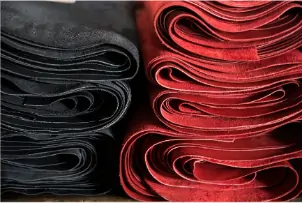
Full grain leather comes from the outermost layer of the hide, which means we (as factories) must be stricter with raw material selection. We need to inspect hides for even thickness (ideally 1.2–1.8mm for most leather goods), minimal surface imperfections (like deep scars or insect bites), and consistent fiber density—any flaw here will show in the final product, since full grain leather is rarely sanded or embossed. Sourcing high-quality full grain hides also means working with trusted tanneries: we often require tanneries to use vegetable tanning (for better durability) or low-chemical chrome tanning, as this reduces preprocessing time (e.g., no need to remove excess dye residue). Unlike top grain leather vs full grain leather (where top grain is sanded to hide flaws), full grain’s “no-touch” policy means our sourcing team spends 30% more time inspecting each hide—but it pays off in fewer production defects.
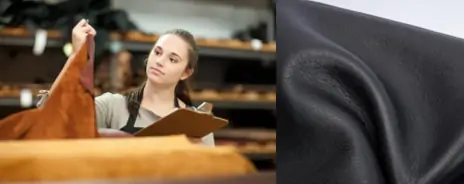
A leather’s “workability” is make-or-break for factories. What works for full grain may cause delays or waste with genuine leather—and vice versa.
Full grain leather’s density and thickness mean we can’t use standard cutting blades. We switch to high-tension steel blades (replaced every 500 cuts, vs every 1,000 for genuine leather) to avoid fraying the natural grain. For stitching, we use heavier thread (40/2 vs 50/2 for genuine) and adjust the sewing machine’s tension to 12–14 PSI (vs 8–10 for genuine)—too low, and the thread won’t penetrate; too high, and the leather stretches. The upside? Full grain’s strength means we have a 2% lower cutting waste rate (since it doesn’t tear during handling) compared to genuine leather. When clients ask about top grain leather vs full grain leather, we explain that top grain is easier to cut (thanks to sanding) but still needs higher tension than genuine—striking a middle ground in production difficulty.
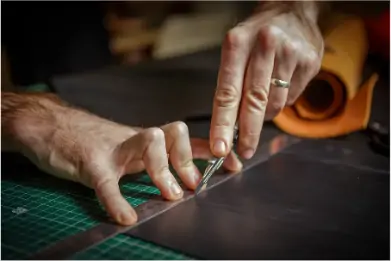
Genuine leather’s heavy processing (dyes, embossing) gives it a uniform surface, which speeds up our finishing step: we only need a light clear coat to protect the color, taking 5 minutes per piece. Full grain leather, however, requires a “spot-finishing” approach—we use a soft wax to enhance the natural grain, and hand-touch up minor imperfections (e.g., small scratches) with matching dye, adding 10–12 minutes per piece. Quality checks also differ: for genuine leather, we focus on coating adhesion (peeling is a common issue) and stitch consistency; for full grain, we inspect for grain alignment (to ensure the natural pattern looks intentional) and patina potential (clients often want full grain to age well). In the genuine vs faux leather context, we also note that faux leather’s finishing is faster (no dye touch-ups) but risks cracking under heat—something we warn clients about if their products will be used in warm environments.
Factories don’t just “make products”—we help clients balance cost, quality, and delivery time. The choice between full grain and genuine leather directly impacts all three.
Full grain leather costs 2.5–3x more per square meter than genuine leather (e.g., 15–20 vs 5–8). But our clients often overlook waste rates: full grain has a 5–7% waste rate (due to strict hide selection), while genuine leather’s thinner, less consistent hides lead to a 10–12% waste rate. For a client making 1,000 handbags (each using 0.5 sqm of leather), full grain would cost ~7,500 (with 375 waste) vs genuine’s ~2,500 (with 250–300 waste)—but the full grain handbags can be priced higher, and we have fewer rejections. When clients ask about cost savings, we also compare genuine vs faux leather: faux is cheaper (3–$4/sqm) but has a 8% waste rate (it tears easily during cutting) and requires specialized sewing machines (adding setup costs).
Full grain leather’s longer preprocessing and finishing times mean we need 3–4 extra production days per order (vs genuine leather). For example, a 500-unit order of full grain leather wallets takes 10–12 days, while genuine leather ones take 7–8 days. This is critical for clients with tight deadlines: we always advise them to choose genuine leather if lead time is under 10 days, unless they’re willing to pay overtime for a dedicated production line. For top grain leather vs full grain leather orders, top grain cuts lead time by 1–2 days (since it needs less spot-finishing), making it a compromise for clients who want better quality than genuine but faster delivery than full grain.
Our job as a factory isn’t just to follow orders—it’s to advise clients based on their product goals, target market, and budget.
Before recommending full grain or genuine leather, we ask clients:
• What’s the product’s intended lifespan? (Full grain for 5+ years, genuine for 2–3 years)
• Will it be used heavily? (e.g., work boots need full grain; seasonal clutches can use genuine)
• What’s the target price point? (Full grain adds 20–50 to production costs per piece)
• Do they need a uniform look? (Genuine for mass-produced items; full grain for artisanal styles)
We also bring samples of full grain, genuine, and top grain leather to show the tactile and visual differences—this helps clients understand why top grain leather vs full grain leather might be a middle ground if their budget is tight but they want better quality than genuine.
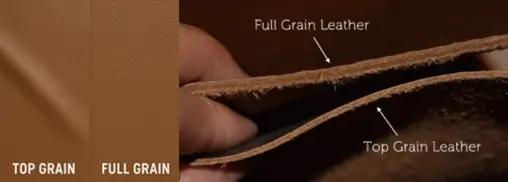
For leather goods factories, the choice between full grain leather vs genuine leather is a operational, not just a material, decision. Full grain leather demands stricter sourcing, specialized equipment, and longer lead times—but it delivers higher quality and fewer defects for luxury clients. Genuine leather, while more cost-effective, requires extra preprocessing to avoid production issues and is best suited for mid-tier, short-to-medium lifespan products. By also guiding clients through the genuine vs faux leather debate (helping them weigh synthetic cost savings against real leather’s market appeal) and clarifying how top grain leather vs full grain leather fits into production workflows, we don’t just “make products”—we become strategic partners for our clients. At the end of the day, a factory’s success depends on choosing the right leather for each order: one that meets the client’s goals, works with our production capabilities, and delivers a final product that sells.
